Uzbek food
Uzbek food
Uzbekistan is very much aligned along the former Silk Road and has therefore benefited for long from an exchange of goods, cultures and ideas with its neighbors and with further located countries as well. This exchange provided especially to its cultural bloom that happened in the Medieval times, as can be seen in the country’s stunning building heritage, crafts and in particularly in the Uzbek food culture.
Uzbekistan is known also for its extraordinary hospitality and Uzbeks truly try to win the visitor’s heart with friendly gestures that are related to eating or drinking. Don’t be surprised if locals invite you to their home for the tea and even try to make sure you don’t leave without having a proper taste of the treats from a “dastarkhan”, which is the Central Asian dining ritual of enjoying rich culinary pleasures in the company of friends and family around a full table. The Uzbek table most often has salads, plov, non bread, fresh seasonal fruits and sweets and first of all, tea.
Uzbek Chaihona & Tea Culture
Tea houses known as Chaihona (chaikhana) are one of the favorite places for Uzbeks to spend time discussing the latest news and to have a rest during the hottest day. Drinking chai (tea) in a chaikhana in Uzbekistan still follows the old Central Asian traditions.
The tea in Uzbekistan is most commonly green tea (kok chai in Uzbek) as it does not only satisfy the thirst and cool the body, but it also helps in the digestion of fatty and often heavy foods. Uzbek tea is very often served together with local sweet type lemon slices and sugar or honey. Uzbek tea houses can vary a lot in shape and size and sometimes you can notice very imaginative structures of Chaihona.
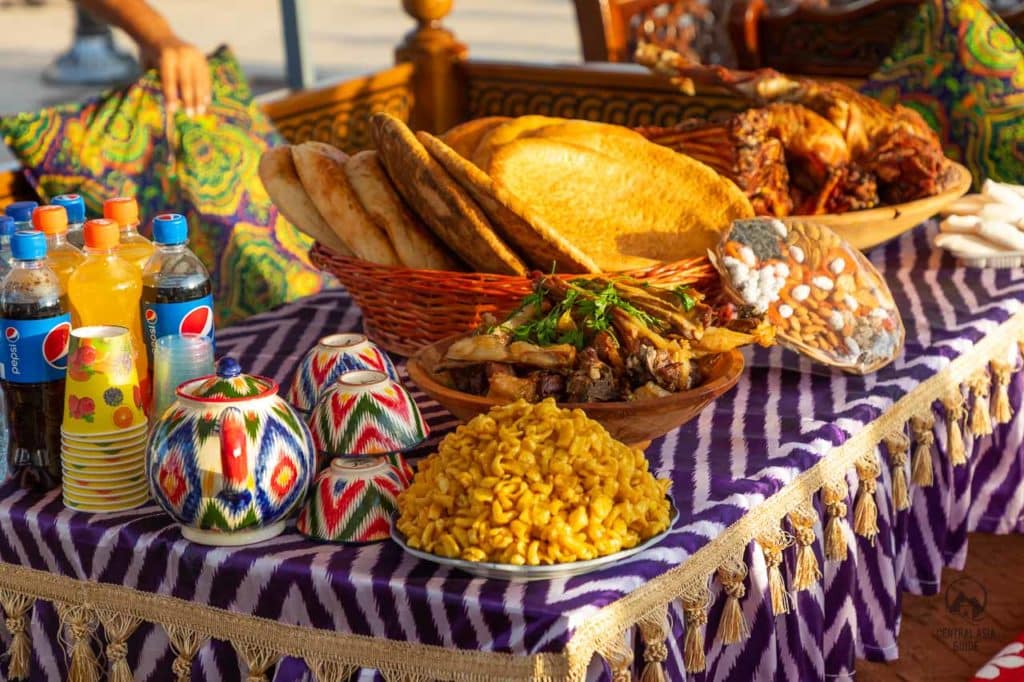
Tea is also the drink of Uzbek hospitality, which is offered first to every guest and is always enjoyed at a table from a piala (a small traditional ceramic bowl without a handle). The way how the tea should be poured to the piala is actually also a very distinctive form of Uzbek (and Central Asian) culture.
In Uzbek culture, the cup should not be filled to the brim, but to somewhat lesser height and therefore the the filling should happen often, which is also a way of showing hospitality and attention to the guest. Allowing the host to refill the cup often also constantly keeps the tea warm. Finally, the tea is always passed and accepted with the right hand and its extra polite to put the left hand over one’s heart when receiving the cup (pro tip for Uzbekistan visitors).
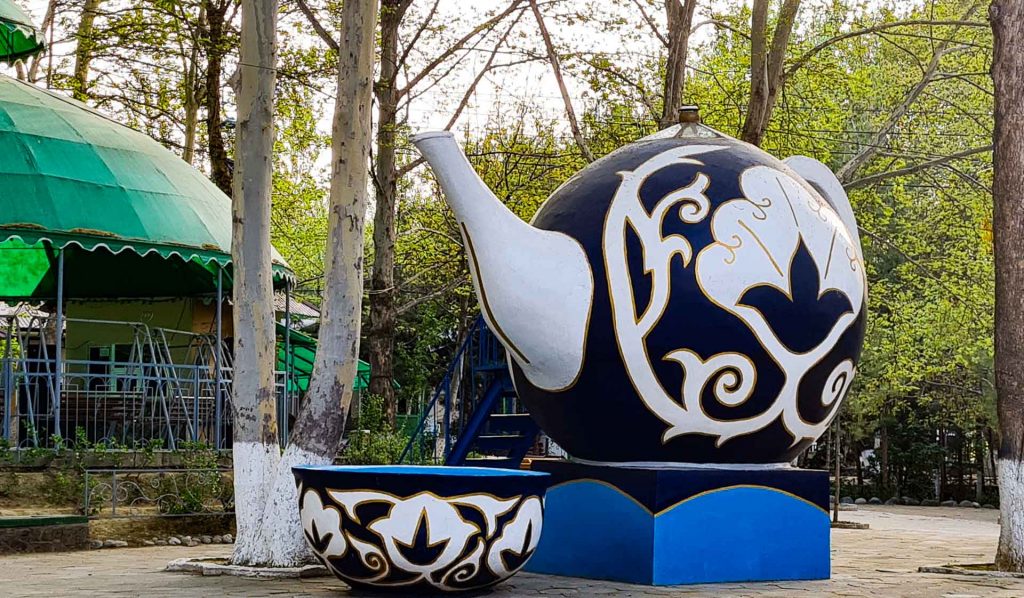
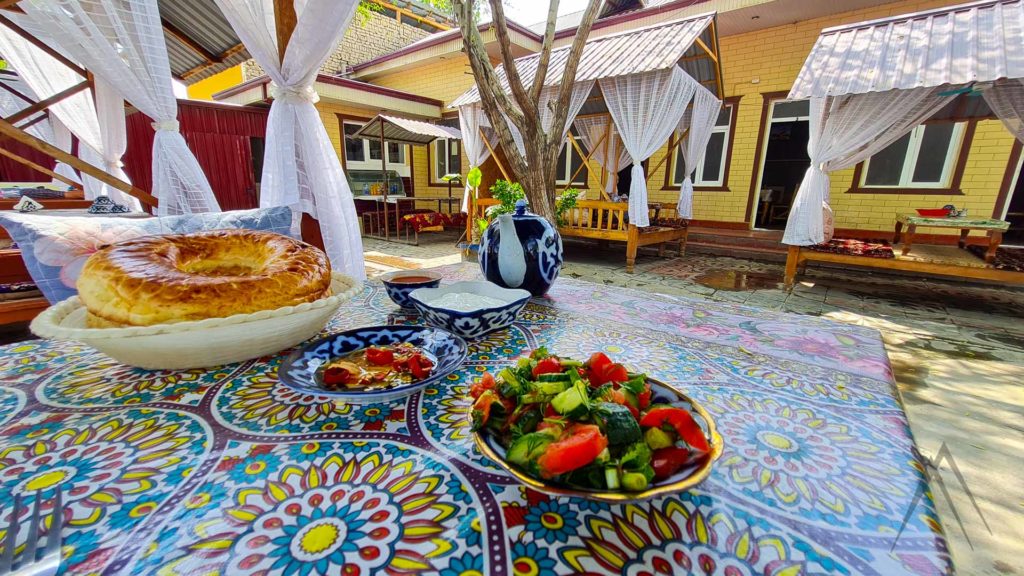
Uzbek Dishes
Uzbek Pilov (Pilaff / Plov)
Pilaff or plov (also known as Osh or Ash, most likely according to the city of Osh in Kyrgyzstan, that is considered the origin of the reddish rice valued in plov) is the main dish of traditional Uzbek cuisine. It is an oily, rice-based dish with pieces of meat, grated carrots, onions and sometimes, roasted garlic, chili and small hard-boiled quail eggs. The English term pilaf is borrowed directly from the Turkish, pilav, which in turn comes from (Classical) Persian polow and eventually derives from Sanskrit pula-ka, “lump of boiled rice”. The English term is though further influenced by Modern Greek pilafi. Due to the vast spread of this dish, there are variations of the name in many languages, including plov, polou, palov, pilau etc but also in the way of preparing the plov.
Uzbek men are proud of their skill of cooking the most unique and tasty pilaff and it is still mostly prepared by only men. It is said that Uzbek pilaff has 1200 different recipes. Here are some of them: Kovurma palov (Fergana pilov), behili palov (pilaff with qunices, sarimsokli palov (bukhoro piladd with raisins), sofakli palov (Samarkand pilaff) and so on. Uzbek plov differs from others as the rice is not steamed, but instead simmered in a rich stew of meat and vegetables called zirvak, until all the liquid has been absorbed into the rice. A limited degree of steaming is commonly achieved by covering the pot.
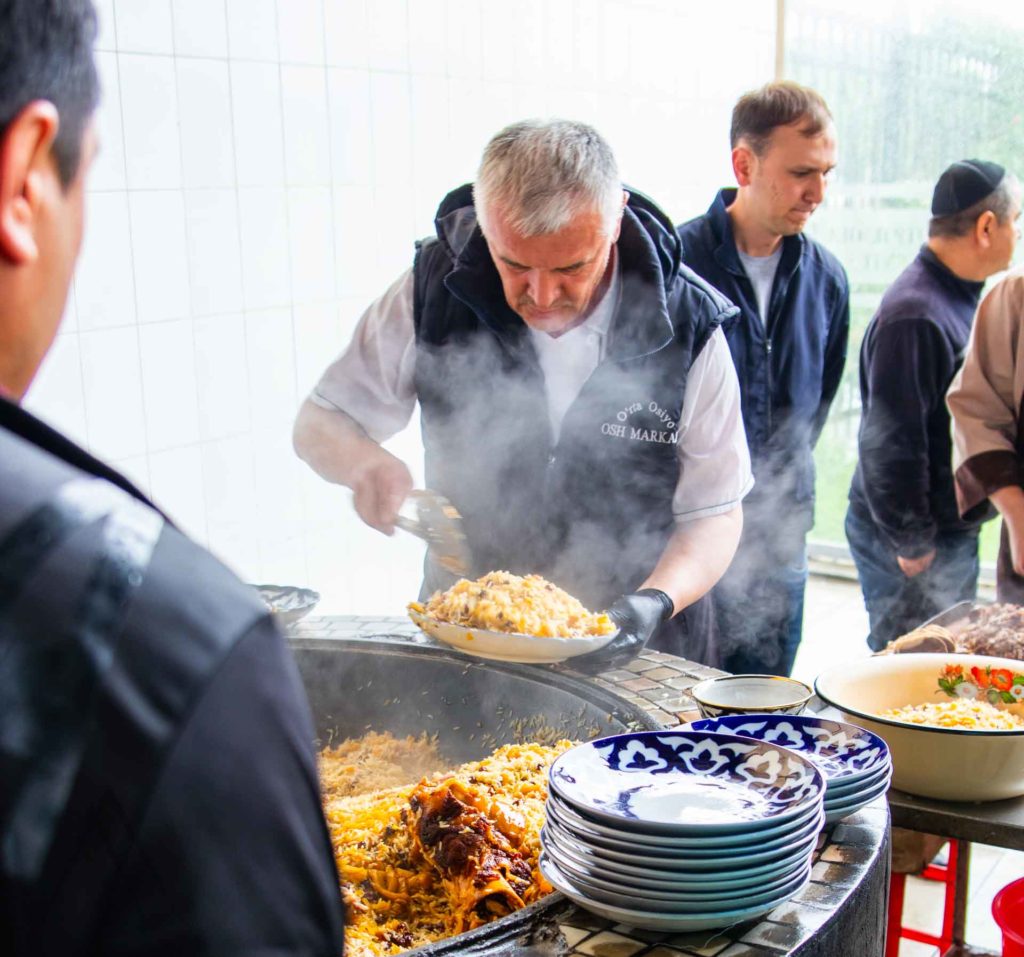

Plov is commonly prepared with lamb and mutton, seared in lamb fat or oil and then stewed with fried onions, garlic and carrots. Chicken plov is rare but can be found in traditional recipes originating in Bukhara. Plov is usually spiced with whole black cumin, coriander, barberries, red pepper, marigold, salt and pepper and heads of garlic and garbanzo beans can be buried into the rice during cooking. Sweet variations, with dried apricots, cranberries and raisins are prepared on special occasions.
Plov is very popular in Russia (as well as other former Soviet republics). It is also the best food at weddings and other large celebrations when huge quantities are cooked as a single dish. Plov is always accompanied by non (bread cooked in clay oven) and is washed down with green tea, which helps to cut through the mutton fat.
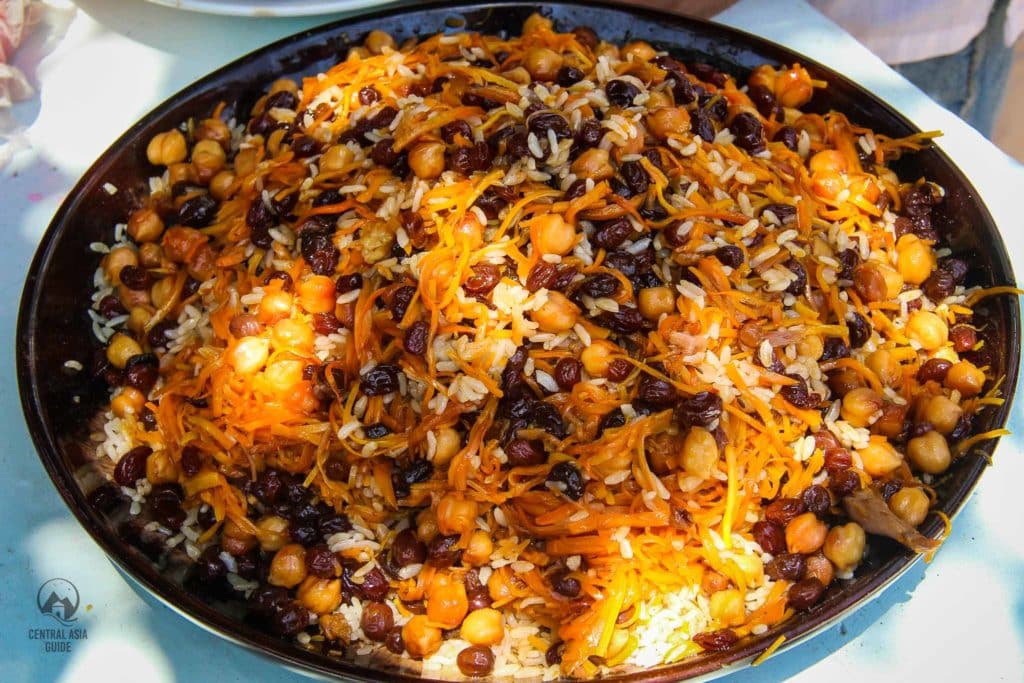

Uzbek Samsa
Samsa (or samosa) is a very popular dish in Uzbekistan known as the “Queen of Uzbek cuisine”. Samosa baked in a tandyr (clay oven), has a specific taste and flavor. Samsas are filled with small pieces of meat, onion and some amount of fat from a sheep’s tail. Today, some sorts of samosa are cooked in gas or electric ovens, which is faster and more convenient and at the same time, makes samosa retain much of its original qualities.
In each region of Uzbekistan, Samsa is baked in its own way with secret ingredients and special skills. For instance, famous samsa such as Jizzakh samsa, is a large round one with meat filling, but Bukhara samsa is baked in triangular shape, Alat samsa has the thinnest dough and juicy filling and Qarshi samsa is in finger shape and elegant in appearance and finally Khorezm samsa is fried with minced meat. There is also a green samsa with greens and spinach to mention few of the many.
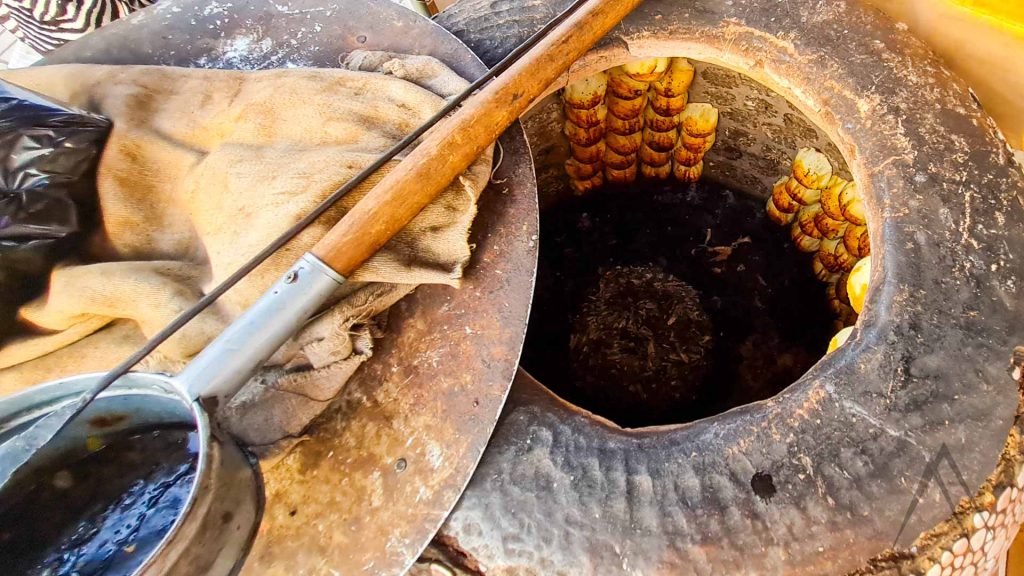
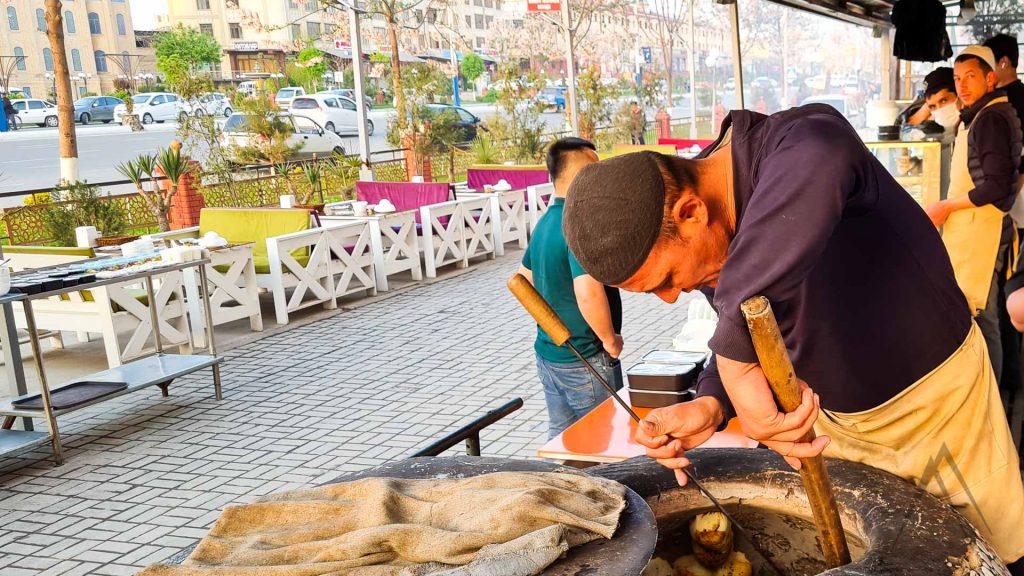
Kok Samsa (Green samsa)
Uzbek green samsa is a special variation of the traditional samsa that is often prepared during the celebration of Nooruz in Uzbekistan. Nooruz is the Persian New Year, which falls on the spring equinox and is celebrated in many countries across Central Asia. The green samsa gets its name from the green herbs that are used to flavor the filling. The filling typically includes a mixture of ground beef or lamb, onions, garlic, and a variety of herbs such as parsley, dill, cilantro, and scallions. The herbs give the filling a fresh and aromatic flavor that is perfect for the spring season.
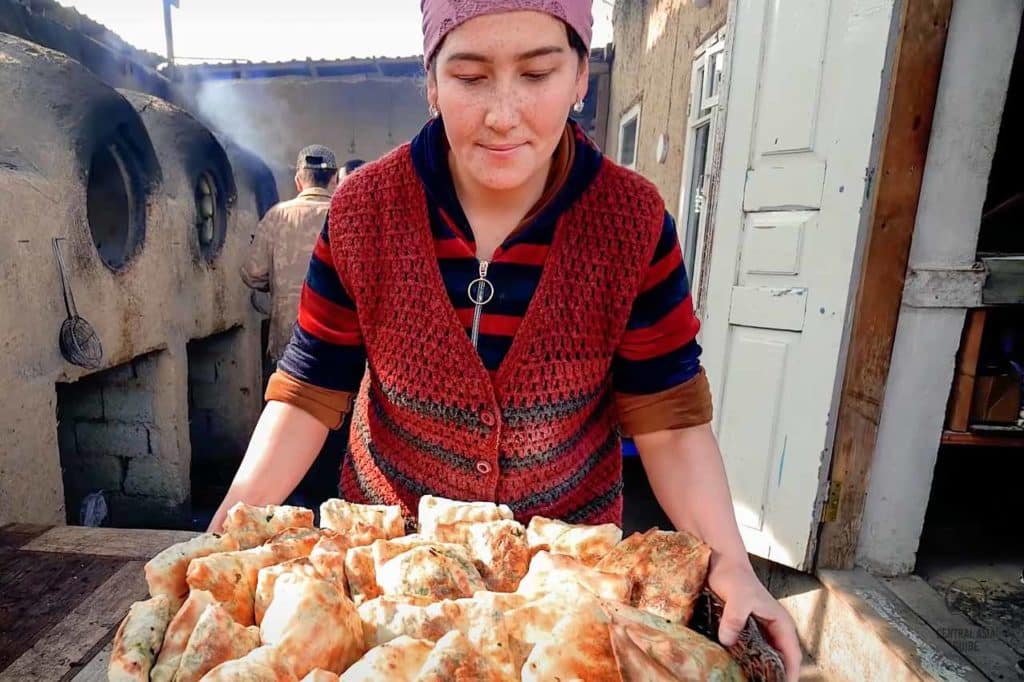
To make green samsa, the filling is first prepared by sautéing the onions and garlic in oil, then adding the ground meat and cooking until browned. The herbs are then added to the mixture and cooked briefly before being used as the filling for the samsa. The dough for green samsa is similar to the traditional samsa, made with flour, water, and yeast. The dough is then rolled out and cut into circles, and the filling is placed in the center of each circle. The dough is then folded over the filling to form a triangle or square shape, and the edges are crimped to seal the samsa. Once assembled, the samsa is baked in a clay tandoor oven until golden brown and crispy.
Green samasa is typically served hot as a snack or appetizer during Nooruz celebrations and is often accompanied by other traditional Uzbek dishes such as plov (rice pilaf) and shashlik (grilled meat skewers).
Parkent Mador Samsa
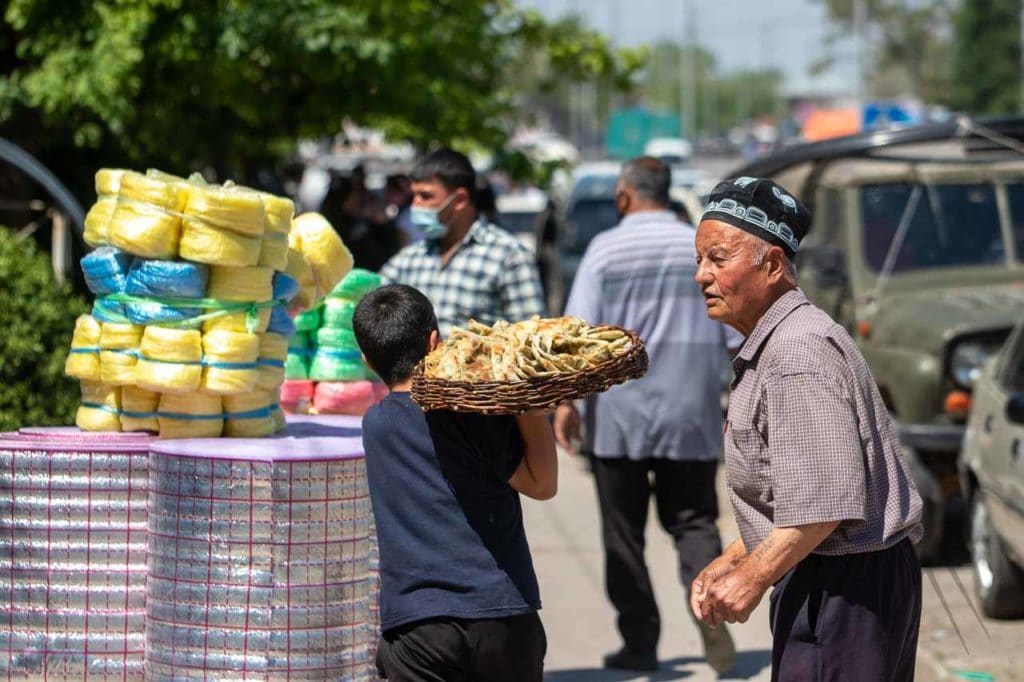
Parkent is popular for its Mador Samsa, prepared from special green plants that are extracted high in the mountains. Allegedly the best chefs of this wonderful spring dish are in Parkent. This treat is only available during the spring and early summer when the nearby hills and mountains are green.
Inside the Mador Samsa one can find steamed, green fresh herbs that give it a particular and quite different taste than the more common meaty version. Mador Samsa is a great example of a local Uzbek food that is not available everywhere.
Shivit Oshi (green noodles of Khiva)
Shivit oshi is also known as the “khorezm lagman” as it is a colorful dish of bright green noodles from Khiva near the border with Turkmenistan in the Khorezm area. Khorezm (or Karakalpakstan) cuisine differs in many ways from the rest of Uzbekistan as fresh herbs and vegetables are used more in the foods like shivit oshi. It is a dish with hand-pulled lagman noodles that are infused with fresh dill which gives them their characteristic green color.
Shivit Oshi is though mainly a summer dish and served only in Khiva so make sure that you try it while visiting the Khorezm region. It can be easily found from most of the Khiva restaurants but rarely elsewhere. Its traditionally enjoyed topped with a meat and vegetable stew and sided with sour cream or plain yogurt.
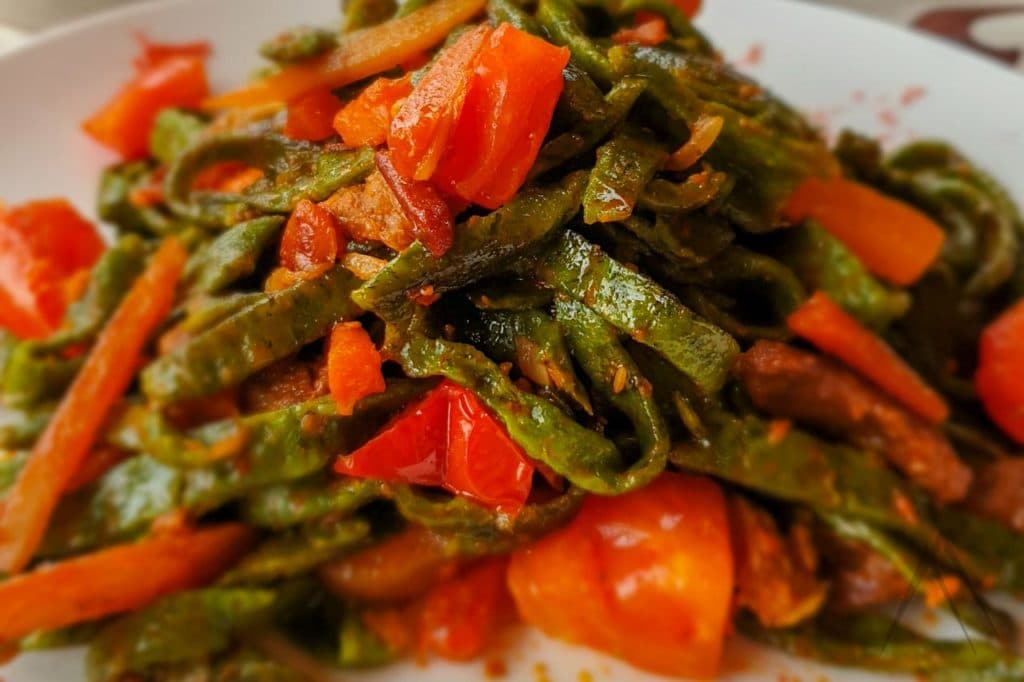
Uzbek Tandyr Non (Bread / Lepyoshka)
The bread in Uzbek called “non” or also knonw as “lepyoshkas” (Russian way), it is a round bread that is a prominent part of Uzbek cuisine. Non breads are baked in special clay ovens called “tandyr“. Bread is a sacred food of Uzbeks. It should not be placed on the ground and never placed faced-down or thrown away in public. During a meal, locals break the bread into pieces and share them around the table.
Lepyoshkas are mentioned in one of the world’s oldest written works, “Eros about Gylgamesh”, the legendary ruler of the Sumerians, who lived no that far from the Caspian Sea almost 5000 years ago. While unearthing the ancient Afrosiab archaeological site in Samarkand, finds also included tandors used by the worshippers.
Uzbek Shurpa (Uzbek Soups)
Soups (Shurpa) are of particular importance in Uzbek cuisine and they are commonly served before the start of the main course. Uzbek soups are often little spicy and rich in vegetables and herbs. Shurpa is usually cooked from fresh or fried meat. Vegetables are cut into large pieces to preserve their flavor. Some of the most common and popular Uzbek soups are Nukhot Shurva, which is a Pea Soup with meat and Kainatma Shurva that is a meat and vegetable stew.
There are dozens of recipes of shurpa (shurva): “shurpa-chaban” – soup with meat, potato, onion and tomato, “shurpa-mash” – mutton soup with green gram, “kaurma-shurpa” – soup with turnip, potato and carrot, “kiyma-shurpa” – soup with meatballs, “sholgom-shurpa”- mutton soup with turnip, “kifta-shurpa” – soup with meat sausages, pea and other vegetables and others.
Another popular Uzbek soup is “mastava“, a soup with meat and vegetables, in which sour milk, pepper and greens are added at serving. Also not less popular soup is “mashkhurda“, a soup with green gram, rice, potato, which is also dressed with sour milk, greens and onion. Cholop is a cold soup with cucumbers, radish, greens and sour milk (great for hangover). Use of sour milk in soups originates from the time, when Turks, ancestors of today Uzbeks, were nomadic tribes. The general name of soups with sour milk is katikli.
Chuchvara
Chuchvara refers to a traditional dumpling dish that’s sometimes also referred to as the Uzbek version of Russian or Italian ravioli. Its similar to common manti but smaller in size and traditionally boiled in a soup with meat and vegetables.
In order to prepare chuchvara, a basic dough is rolled out and cut into smaller squares before being stuffed with a mixture of minced meat (usually lamb or beef), onions and seasoning. The dumplings are then boiled in broth with fried meat and vegetables. Chuchvara is often served with a sprinkle of fresh dill and you can think of chuchvara as the Uzbek version of the Chinese wonton soup.

Chuchvara can be fried as well and it is then called Kovurma chuchvara or fried chuchvara. They are commonly cooked in hot oil and typically served with a side of sour cream or cold yogurt.
Other types of chuchvara in Uzbekistan include osh kuktli chuchvara and ugra chuchvara. The former is made with a stuffing of finely chopped greens, onions, tail fat, and hard-boiled eggs while the latter consists of classic chuchvara dumplings cooked in a soup with meatballs and noodles.
Khanum
More commonly known as hanum, although it has various spellings such as khanum, khanym, hanon and even depending on the geographical location the name of the food differs, for instance in the Fergana valley it is called urama, which is translated as “bundle” or “wrapped”, on the method of cooking Uzbek hanum. There is similar food in neighboring Kyrgyzstan called oromo.
Khannum is a steamed floury dish in Uzbek cuisine with a stuffing of potatoes, minced meat, or pumpkin. The spice of this dish is the combination of the finest dough and juicy filling. Khanums can be in various forms like roses, lace envelopes, and just rolls. You can get it in any national restaurant and even in Uzbekistan bazaars, they sell ready-made Khanum with potatoes.
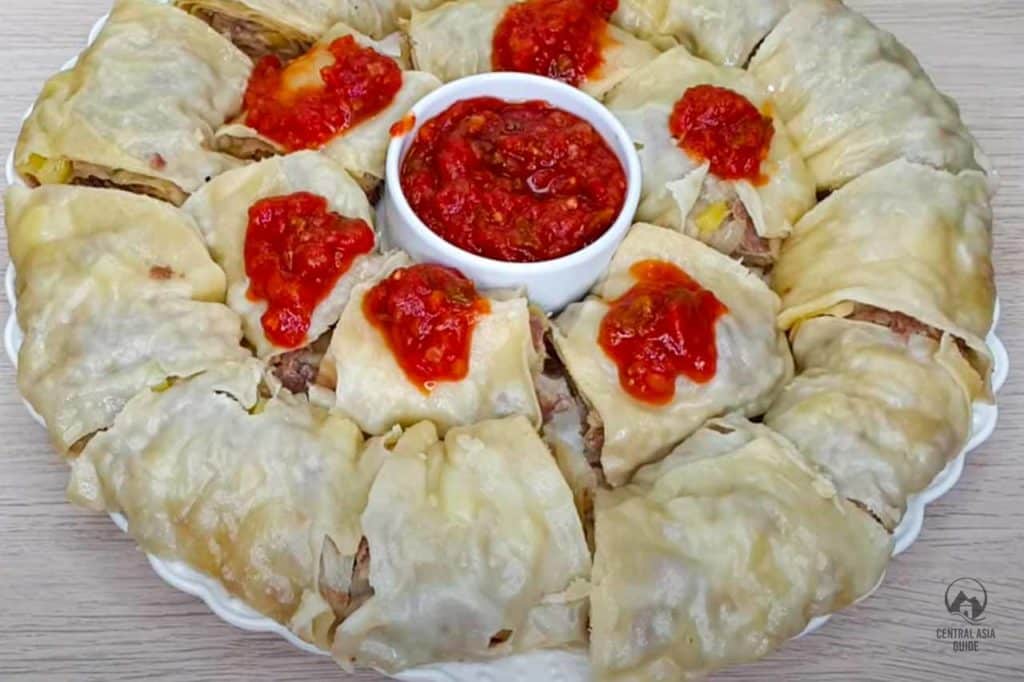
Tandyr kebob
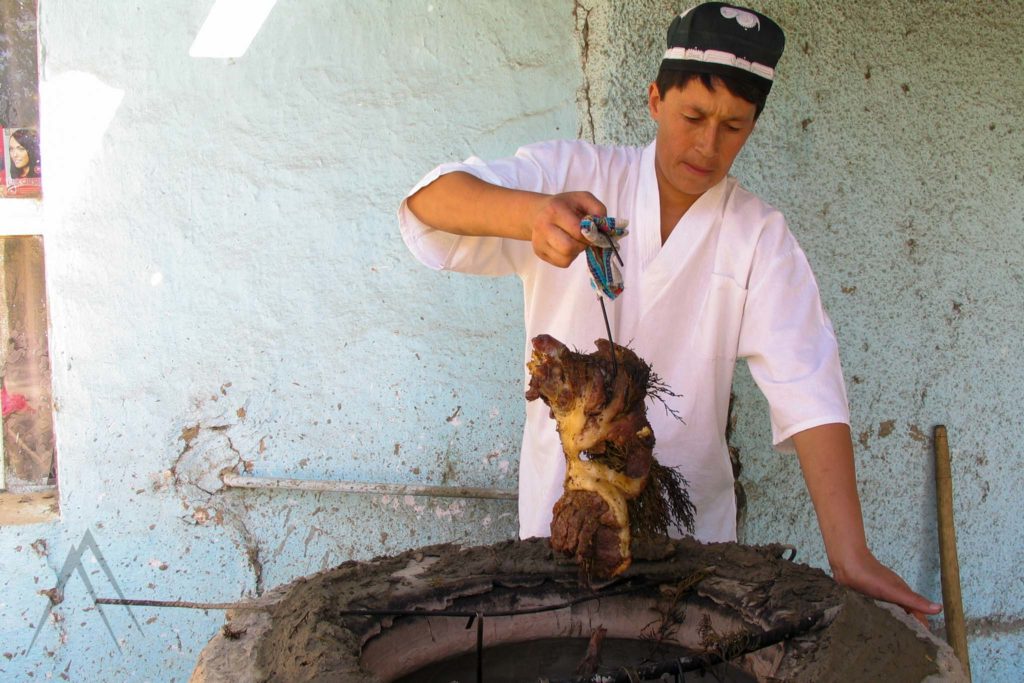
Tandoor kebab is a lump of goat meat baked in a tandoor oven. Like many other kebabs, tandoor kebab has been known since ancient times, first as the food of Turkic nomads, warriors and wanderers that later spread among the settled inhabitants of Maverannahr and Khorezm. The meat of fat-tailed rams is usually used to prepare the dish and often replaced by goat meat in the more mountainous areas. Beef and non-tailed lamb work well with this food as well.
The meat is seasoned with juniper needles, which gives it a peculiar taste. Juniper branches are also placed in the hearth to flavor the smoke. The combination of intense heat and limited air in the tandoor gives the meat a special tender texture. A semi-finished tandoor kebab is laid out for finishing on an iron baking sheet. A fully prepared dish is served with freshly cut vegetables (onions, tomatoes), herbs, yeast cakes (tandoor-nan) and hot green tea.
Uzbek Shashlik
In Uzbekistan Shashlik (a meat skewer) is a very common dish that is sold in the streets, cafes, restaurants and bazars all alike. In Uzbekistain (like in all Central Asia) shashlik is most commonly made from mutton or chicken or beef (even horse meat) and served with onions, vinegar and tomato sauce. In order to make the shaslyk more juicy (fatty), every second or every third piece in the skewer is often a piece of fat.
The word shashlik comes from shashlyk, the Russian word for “shish kabob” and Uzbek Shashlik is actually one version of the common shish kabob that’s eaten in many countries also in Caucasus and in other former Soviet Republics like Lithuania and Ukraine.
In addition to the pieces of meat on a skewere, meat rolls made with minced beef or mutton are common, as are skewered and grilled chicken legs.
No matter the meat, shashlik skewers are typically filled with just meat, fat, mushrooms and vegetables. If you prefer vegetarian food or just feel like eating too much meat while visiting Uzbekistan, then you can order grilled skewers of just potatoes, vegetables, or mushrooms as well.
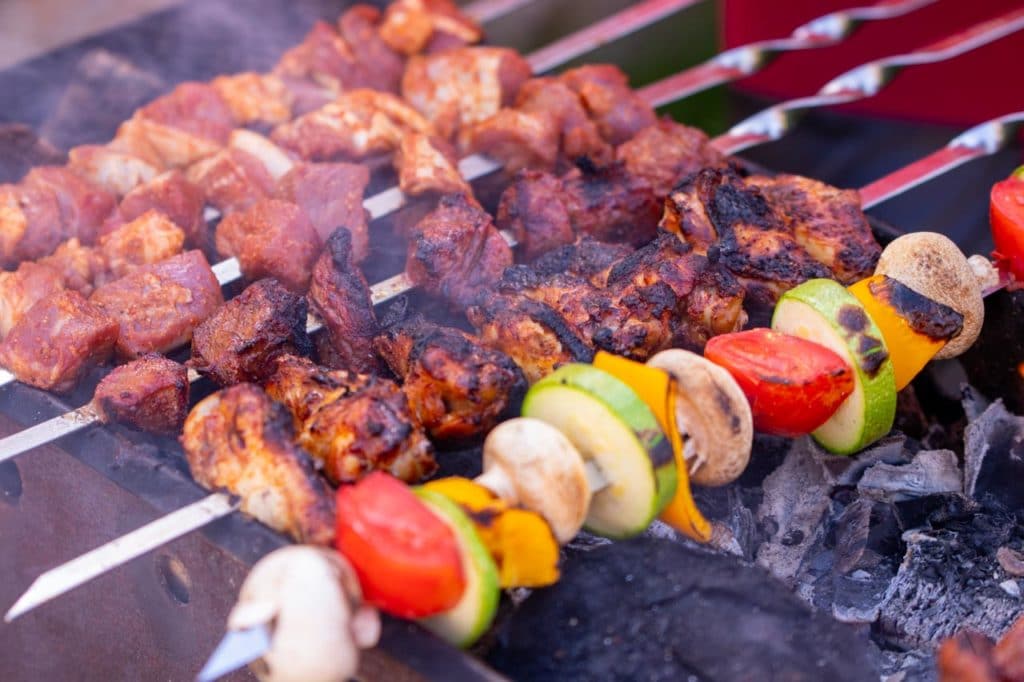
Uzbek salads
As Uzbekistan is a major producer of fruits and vegetables, it has a variety of delicious salads. Autumn and summer periods are the best salad season due to the most fresh ingredients.
Achichuk / Shakarap
Achichuk is an Uzbek salad made with fresh (red) onions, tomatoes, chili pepper, herbs and seasonings. It is often served as a side dish with plov and its one of the simplest local salads you can try in Uzbekistan.
Uzbek Appetizers
Halva
Halva is a well-known type of sweet in many Asian and Arabic countries and its name literally translates as “sweets” from the Arabic language. It is normally made and sold in different sized bricks and pieces, with a crumbling texture that melts in your mouth, releasing an amazing combination of tastes. Uzbekistan has an astonishing amount of halva varieties, ranging from simple nut-based halvas to complex halvas with chocolate-creamy tastes to pistachio and even Snickers taste. Sometimes they comprise of more than a dozen ingredients and are made with quite elaborated recipes.

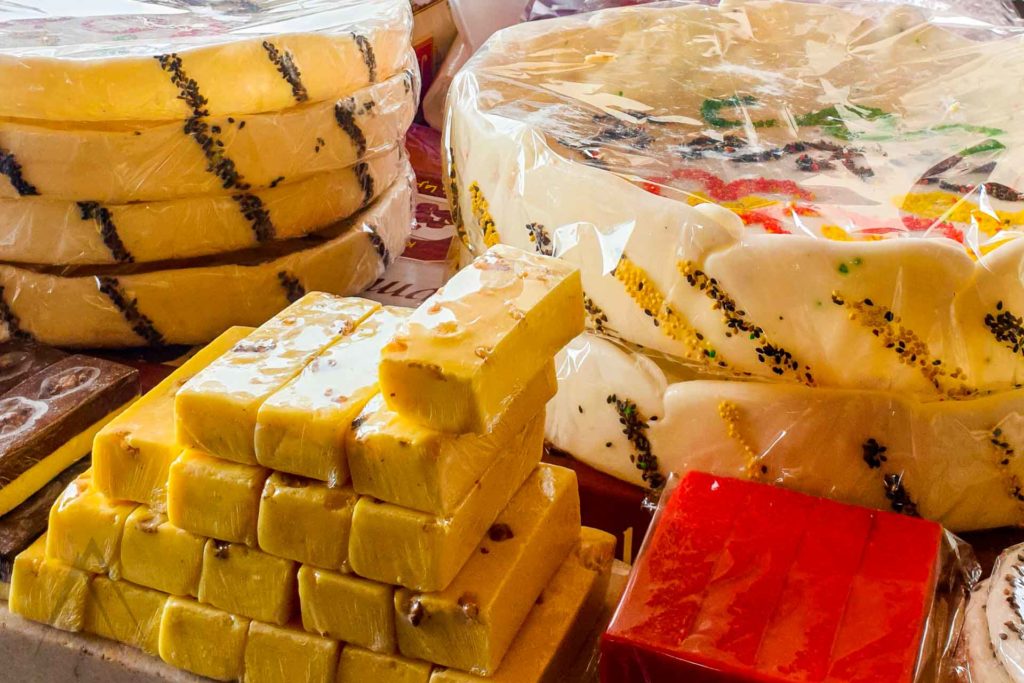
Navat (crystal sugar)
Navat is a traditional Uzbek tea sweetener, more precisely a crystalline sugar, a monosaccharide made of fructose and glucose. It is made from grape juice with the addition of certain spices or concentrated sugar syrup. Navat is normally yellowish-white to dark yellow or brown, depending on the boiling time. Navat has a number of curative effects and is used in folk medicine as cough and throat cure or dissolved in green tea, for curing many other illnesses.
Enjoy Uzbek food during our tours
Best destinations to enjoy Uzbek Cuisine
Page updated 12.2.2022